Your holiday sees you windswept on a mountaintop, or in a field of wildflowers; hugging a koala, or making friends
with a quokka; gazing awestruck at the belly of a gigantic whale, or standing, minuscule, at the foot of an enormous tree…
For Naturalists, the simple things in life are always the finest: a never-ending stretch of road, a field of wildflowers, camping in towering forest as you hike your way down the Bibbulmun Track. Western Australia is a wide land of unspoilt nature, and when it comes to endemic species – that's to say those that can only be found here – the state has more than you can poke a camera at. So acquaint yourself with WA's best green-stays, its hidden caves, and the isolated spots within its pristine ecosystems, from which you can enjoy the most dazzling, star-filled skies you'll ever see. Ready to reconnect with nature? You've come to the right place.
NATIONAL PARKS
Western Australia is blessed with more than 50 national parks. More than 16 million people per year visit over 28 million hectares of land and water in conservation parks, marine parks and reserves, regional parks, nature reserves and state forest. These world-class resources are managed by the Department of Parks and Wildlife, responsible for protecting these unique landscapes, especially
the Biodiversity Hotspots.
WA's nature hotspots
Australia is one of seventeen countries described as being 'megadiverse'. These countries cover less than 10 per cent of the earth, but support more than 70 per cent of its biological diversity. Largely undisturbed natural ecosystems, these hotspots have thriving native plant life, animals and communities, as well as a wide range of locally endemic species that are rarely found outside the hotspot, if at all.
Eight of Australia's 15 National Biodiversity Hotspots are in WA:
-
�Fitzgerald River Ravensthorpe
-
�Busselton Augusta
-
�Central and Eastern
-
Avon Wheatbelt
-
�Mount Lesueur-Eneabba
-
�Geraldton to Shark Bay sand plains
-
�Carnarvon Basin
-
�Hamersley-Pilbara
-
�North Kimberley
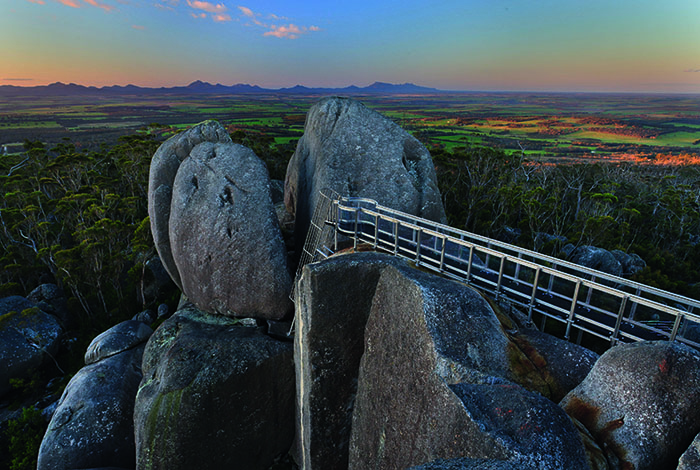
Castle Rock.
The South West Ecoregion
Australia's only Global Biodiversity Hotspot, the South West Australia Ecoregion (SWAE), is located right here in WA.
A fragile Mediterranean biome with the highest concentration of rare and endangered species in Australia, the region stretches from Shark Bay in the north to Esperance in the south, and includes the Avon region, accounting for 48.9 million hectares.
Although it only covers five per cent of the Australian land mass, the SWAE contains more than one-third of Australia's known flowering plants (about 8000 plant species) – and 75 per cent of the plants discovered there so far are native to WA.
A menagerie of animals, birds and fungi species also call the SWAE home, many of which, like the plants, are also endemic – that's seven species of mammals, 13 species of birds, 34 species of reptiles, and 28 species of frogs. Scientists guess that high numbers of native invertebrate species (insects) are also present.
It goes without saying that exploring these wildernesses is a privilege, and must be done with great care.
.jpg)
Boranup Forest (photography Insight Photography)
Treks and hiking
Hankering to lace up your boots and experience WA's amazing landscapes on foot? Plan your walk in advance – this is a big state, and it's not somewhere you'll want to get lost.
TOP TRACKS
-
�Cape to Cape Track (135km) Runs along the spine of the Leeuwin Naturaliste Region, mostly following the coast.
-
�Cathedral Gorge Walk (4km) Located within the Bungle Bungle Range in Purnululu National Park.
-
�Gorge Rim Walk, Dales Gorge (2km) Tracks go between Circular Pool Lookout and Fortescue Falls in Karijini National Park.
-
�Kalbarri Loop Walk (8km) A challenging walk in Kalbarri National Park.
-
�Lesueur Walk Trail (8km) A hiking trail for wildflower enthusiasts.
-
�Woylie Walk (5.5km) A family-friendly trail through Dryandra Woodland's conservation area.
-
�Summit Trail, Mount Augustus (12km) Suitable for experienced hikers only. Mount Augustus is twice as high as Uluru.
-
�Bluff Knoll, Stirling Range (3.3km) The third-highest peak in WA. Great for spotting wildflowers and animal life.
-
�Warren River Loop Walk (10.5km) Wanders from the Pemberton karri forest to the Warren River.
-
�Bibbulmun Track (1003km) Runs in remote bushland from Kalamunda to Albany.
TOP 5 FAMILY-FRIENDLY WALKS
1 �Kings Park Botanical Walk, Perth
2 �Valley of the Giants Tree Top
Walk, near Walpole
3 �Araluen Botanic Garden
Walks, Roleystone
4 �Rotary Walk Trail, Esperance
5 �Portagabra Track, Mundaring
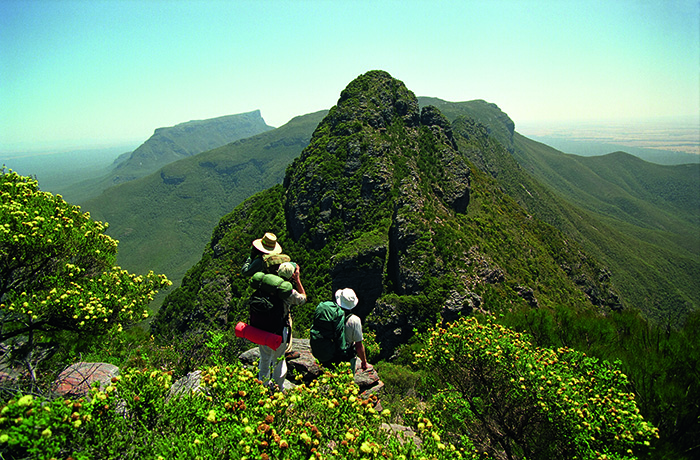
If you wish to visit a number of these incredible National Park Sites, a park pass will come in handy: information can be found at parks.dpaw.wa.gov.au, by calling (08) 9219 9000, or by downloading the new ParkFinder WA phone app.
Cave exploring
WA is as beautiful underground as it is above, so be sure to add these majestic caves to your itinerary. The ancient limestone and crystal formations are breathtaking.
PERTH Crystal Cave and Cabaret Cave, Yanchep National Park.
DOWN SOUTH Jewel Cave, Ngilgi Cave, Mammoth Cave, Lake Cave, Mulka's Cave, Calgardup Cave, Moondyne Cave, and Giants Cave.
UP NORTH Mimbi Caves (with Girloorloo Tours), Tunnel Creek National Park's cave systems, and the caves at Stockyard Gully National Park.
.jpg)
Ngilgi Cave (photography Elements Margaret River)
To the Bibbulmun and beyond
It's listed as one of the top 20 trails in the world, so why haven't you attempted the vast 1003km stretch of the Bibbulmun Track yet? Take a guided tour or, better yet, grab some friends and sign up to the annual Bibbulmun & Beyond Nine-Day Tour, held in May. Incorporating full- and half-day walks, the event traverses sections of the main track and out past it to the Stirling Range National Park near Albany. Each evening, you can return to comfortable accommodation in nearby rural towns. For more details, call (08) 9481 0551, or visit bibbulmuntrack.org.au.
Behold the Bungle Bungles
It's a pretty weird name, hey? Well, it is the world's weirdest mountain range! Found at Purnululu National Park, the World Heritage-listed Bungle Bungle Range has been around for 350 million years, and has been celebrated by its Aboriginal inheritors for 40,000 years. While the national park was initially kept secret until 1983, the maze of black and orange sandstone domes is now one of the Kimberley's best attractions. Fly, drive, or walk your way to the unique yet wonderful formations.
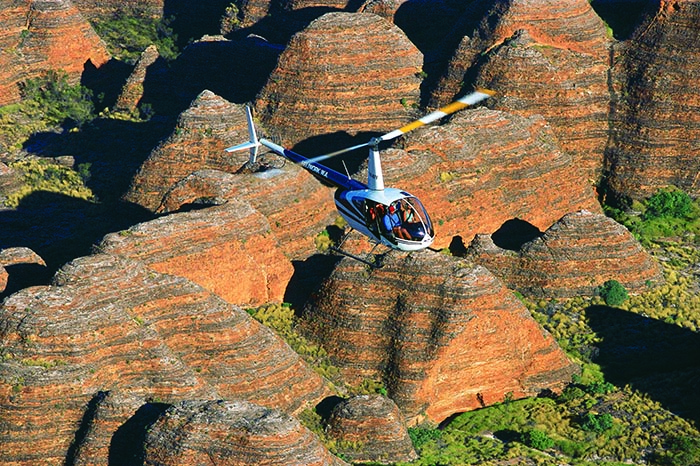
Flying over the Bungle Bungles.
CREATURES GREAT & SMALL
WA has a whole host of wildlife with which to become acquainted, from tiny birds to some of the largest creatures on the entire planet.
Whale Watching
Western Australia has one of the longest whale-watching seasons in the world – eight months of the year, from May to December. It's all thanks to the epic annual migration of humpback and southern right whales from the food-rich Southern Ocean to warm breeding grounds on the north Kimberley coast and back. If you're extremely fortunate, you may even come up close to the rare blue whale.
The best time to observe these gentle ocean giants from the coastline is at midday, when the sun is directly overhead. To get closer to the breaching, spy-hopping and tail-slapping action, jump aboard one of the many whale-watching cruises available.
THE WHEN AND WHERE OF WHALES
-
�From May to September, whales gather to rest and play in Flinders Bay, Augusta.
-
�Between July and October, you can see them frolic around King George Sound, Albany.
-
�From June to November, the humpback whales reach Kalbarri, Exmouth, Coral Bay, Broome and the Kimberley coast, where they strike up their romances. Try Camden Sound Marine Park for humpbacks, and Ningaloo Marine Park for blue whales and humpbacks. Around mid-August, humpbacks and their newborn calves come in close to shore at Kalbarri and Exmouth as well as Carnarvon.
-
�On their return journey, between September and December, humpback families take a rest-stop in the coastal waters of Perth and Geographe Bay.
-
�Catch the tail-end of the season by joining a tour from Rottnest Island, Fremantle or Hillarys, Dunsborough or Busselton, or further south in Esperance or Bremer Bay.
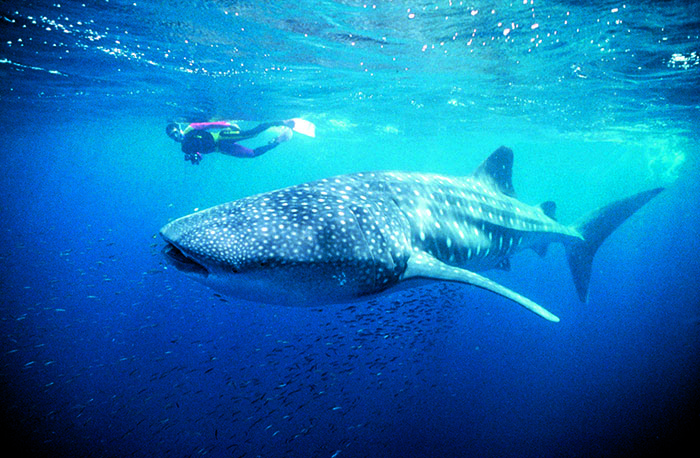
Wildlife parks
There are great zoos in Perth and Peel, as well as the fantastic Aquarium of Western Australia at Hillarys Boat Harbour, Perth. However, there's nothing quite like seeing animals in their natural habitat. The perfect day trip for all the family, a visit to a wildlife park offers the unique opportunity to get right up close to Australian native animals like kangaroos, koalas and quokkas, as well as many rare and endemic marsupials, mammals, birds and reptiles. Top wildlife park destinations include:
-
Malcolm Douglas Crocodile
-
Park, Roebuck, Kimberley
-
Caversham Wildlife Park, Swan Valley
-
Cohuna Koala Park, Byford, Perth
-
Armadale Reptile & Wildlife Centre
-
Kanyana Wildlife Rehabilitation Centre, Lesmurdie, Perth
-
Greenough Wildlife & Bird Park
-
Eagles Heritage Raptor
-
Wildlife Centre, Margaret River
FOR KIDS
-
Big Swamp Parkland, Bunbury Wildlife Park
-
Uralla Wildlife
-
Sanctuary, Perilup
-
Waminda Wildlife
-
Sanctuary, Geraldton
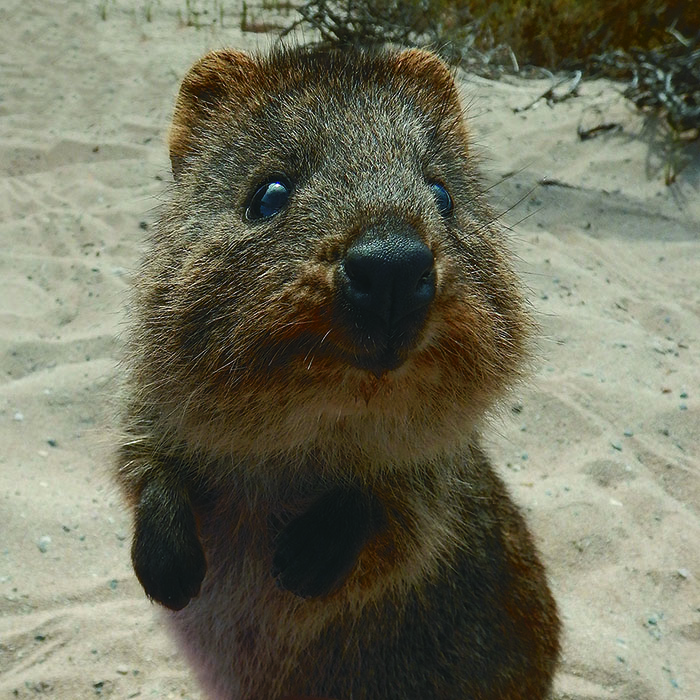
Quokkas are unique to the South West Australia Ecoregion.
The quokka
The quokka (Sextonix brachyrus) can only be found in the SWAE, but while there are plenty of the happy little critters on Rottnest and on Bald Island near Albany, their population has declined on the mainland since European settlement. Sadly the quokka is now endangered, with fire being the biggest threat to its numbers.
Camel riding
Australia's wild camel population is the biggest in the world. For a closer encounter, seek out a camel farm or safari. Sunset Camel Rides are available along Cable Beach, Broome. There are three companies that run camel safaris, at 3pm and sunset – the red, blue and yellow camels. You can also ride camels at Monkey Mia in Shark Bay. In the Perth Hills is the Calamunnda Camel Farm, where you can take camel rides and treks on the Bibbulmun Track. Visit camelfarm.com for info. Humpy Camels run rides for kids during the school holidays, from Simmo's Icecream in Dunsborough. Just east of Ravensthorpe on the Fitzgerald Coast, Eremia Camel Farm offers trekking between June and October, and beach trekking near Hopetoun from December to April. By appointment only – visit camelsravensthorpe.com.au.
Turtles
From October to February each year, thousands of marine turtles nest at night in the Pilbara. Port Hedland's beaches are where you're most likely to spot them, but don't forget they're protected, so be careful not to disturb them.
Manta rays
WA boasts the largest species of ray in the world, which can grow to more than 7m, and weigh in at a whopping 2000kg. A popular spot to swim with them is Coral Bay, from June to November.
Crocodiles
Watching crocodiles in the wild can be exciting, but stick to a tour for this one, folks – you don't want to end up as dinner. There are many cruises in the Kimberley that include croc-watching as part of the itinerary. TIP Keep your eyes peeled for crocodile-warning signs, and don't assume somewhere is safe for swimming. Ask first.
.jpg)
Swans on the water (photography Georgina Steytler).
Birds
Did you know Australia has more than 810 species of birds, with almost 550 recorded in our state alone? Birdlife WA shares its tips on the best places to spot them.
-
HERDSMAN LAKE, STIRLING Almost 140 species have been recorded here. It's a good site for waterbirds, including black swans, yellow-billed spoonbills, musk ducks, blue-billed ducks, Australian pelicans and eastern great egrets. Birds of prey include the whistling kite and swamp harrier, while honeyeaters comprise the red wattlebird, singing honeyeater and brown honeyeater.
-
CHEYNES BEACH, ALBANY Ten of the 16 birds unique to Western Australia can be found here: the Carnaby's black cockatoo, western rosella, red-capped parrot, noisy scrubbird, red-winged fairy wren, western bristlebird, western wattlebird, western spinebill, white-breasted robin and red-eared firetail. It is also a good location to see western whipbirds and southern emu wrens.
-
BROOME Almost 300 bird species have been recorded at the Broome Bird Observatory, including the yellow chat, white-breasted whistler, dusky gerygone, broad-billed flycatcher, oriental pratincole, and red-headed honeyeater, as well as shorebirds like the common redshank, Asian dowitcher and broad-billed sandpiper.
-
KUNUNURRA There are about 200 bird species around Kununurra, with waterbirds, raptors, finches and honeyeaters among the highlights. Birds to look out for include the magpie goose, wandering whistling duck, radjah shelduck, green pygmy goose, whistling kite, black kite, comb-crested jacana, blue-faced honeyeater, double-barred finch, crimson finch and star finch.
-
DRYANDRA WOODLAND, NEAR NARROGIN More than 120 species have been recorded here, including unique WA species such as the western rosella, red-capped parrot, western thornbill, western spinebill and western wattlebird. Other birds regularly seen are grey currawong, restless flycatcher, grey fantail, yellow-plumed honeyeater, Australian ringneck and purple-crowned lorikeet.
BIRD-SPOTTING TIPS
-
Take your time and walk slowly.
-
Be quiet and listen for birds calling.
-
Go early in the morning, when birds are more active.
-
Carry a field guide such as Simpson & Day. Using the image guide to match up and identify birds becomes quite addictive, and is a great way to keep kids entertained.
-
Download an app such as BirdLife Australia's Wetland Birds Field Guide, or Michael Morcombe eGuide to the Birds of Australia.
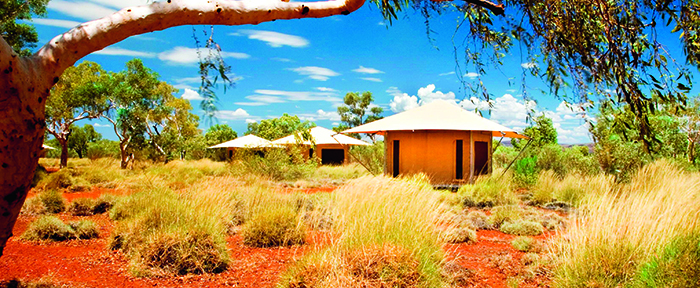
Outback eco tents (photography Karijini Eco Retreat).
ECO TRAVEL
Go green on your next holiday – take only photos, leave only footprints, and maybe even give a little bit back. More and more eco-retreats and tour operators are opening in gorgeous natural settings around the state.
Top eco-retreats
RAMADA Eco Beach Broome A multi award-winning, sustainable resort in the pristine Kimberley region. There are eco villas and eco safari tents, and tours include guided cultural bushwalks, turtle tagging, a tour of the resort's off-the-grid power plants and veggie gardens, and more. (08) 9193 8015, ecobeach.com.auhttp://ecobeach.com.au.
Home Valley Station An outback heritage cattle station set in the Kimberley wilderness. Stay in one of the safari-style eco tents. (08) 9161 4322, hvstation.com.au.
Mitchell Falls, Bell Gorge and Bungle Bungle Wilderness Lodges These three destinations offer tented cabins with ensuites and private decks in idyllic bush settings. 1300 334 872, kimberleywilderness.com.au.
Big 4 Peppermint Park, Busselton An award-winning eco village nestled within 8ha of natural bushland. Eco-friendly accommodation includes self-contained cabins, and powered and unpowered campsites. 1800 281 411, peppermintpark.com.au.
Forrest Rise Eco Retreat Located in Yelverton near Margaret River, this low-density holiday accommodation alternative is set on 97ha of bushland. Two multi-geared mountain bikes and a backpack are provided to each eco chalet, encouraging visitors to explore. (08) 9755 7110, forestrise.com.au.
Karijini Eco Retreat Deluxe eco cabins and tents at Joffre Gorge in Karijini National Park. (08) 9425 5591, karijiniecoretreat.com.au.
Coco Eco NATURE Retreat This B&B-style retreat boasts self-sufficient treetop rooms with views over Cable Beach. Each incorporates integrated solar-power, and has tropical ice boxes as an energy-efficient alternative to bar-fridges. 0408 921 454.
Yelverton Brook Eco Retreat Solar-oriented and water- and energy-efficient cottages set on 40ha north of Margaret River. Every chalet comes with wildlife feed and marsupial information. (08) 9755 7579, yelvertonbrook.com.au.
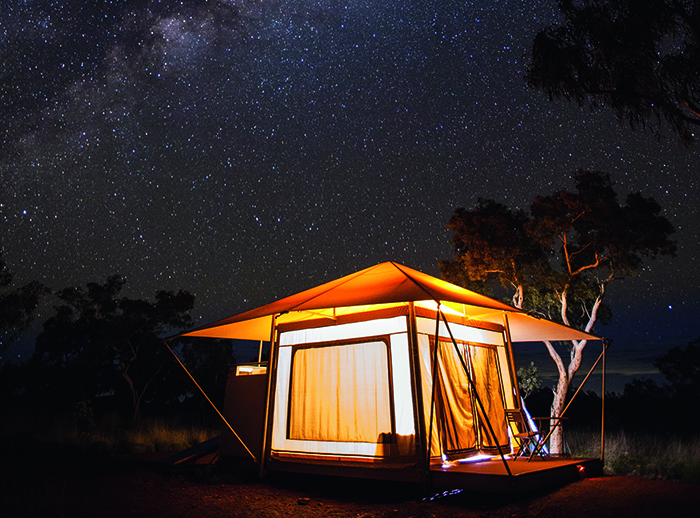
Spend the night under the stars in an eco tent (photography Karijini Eco Retreat).
Altruistic adventures
You don't have to go overseas for a trip with an altruistic edge. Give back to the communities you visit, and forge an even deeper bond with the land on these volunteer initiatives, or visit conservationvolunteers.com.au and volunteeringwa.org.au for activities close to home.
Eco Beach Turtle Conservation Help monitor the local flatback turtle population in this scientific research program between November and January. conservationvolunteers.com.au/get-involved/holidays/eco-beach.
Kimberley Adventure A six-day adventure across the Kimberley, with the chance to participate in hands-on conservation projects at Mornington Station, including weed control, flood debris removal, and clearing and assistance with track maintenance. conservationvolunteers.com.au/get-involved/holidays/Kimberley-Adventure.
Ningaloo Reef Research Expedition A five-day trip on which you can participate in marine research of the coral reef, including data collection and processing. conservationvolunteers.com.au/get-involved/holidays/ningaloo-reef-research-expedition.
Australian Wildlife Conservancy The AWC often has volunteering positions available at wildlife sanctuaries in remote WA. Visit australianwildlife.org/support-awc/volunteering to find out more.
Indigenous Community Volunteers Volunteer opportunities in indigenous communities. Visit icv.com.au/how-you-can-help/volunteer/.

Hancock Gorge (photography Karijini Eco Retreat).
Top eco tours
-
Pemberton Discovery Tours Explore the Warren and D'Entrecasteaux National Parks, see natural wildlife, Lake Jasper and more. (08) 9776 0484, pembertondiscoverytours.com.au
-
�Albany Walking Holidays Explore the South West Australia Ecoregion on foot with a self-guided leisure walk, returning to comfortable accommodation at night. 0448 414 153, walkinginalbany.com.au.
-
�Oceanwise Join a Whale Shark Research Expedition in the Ningaloo Coast World Heritage area. Swim with the whale sharks, and help researchers collect important info about the majestic creatures. 0439 996 018, oceanwise.com.au.
-
�Dolphin Discovery Centre The 90-minute Dolphin Eco Cruise within Bunbury's Koombana Bay introduces you to the local bottlenose dolphins, with informative commentary and the chance to swim with these wonderfully playful mammals. (08) 9791 3088, dolphindiscovery.com.au.
-
�Kimberley Wilderness 4WD Adventures Learn about the Kimberley region's epic landscapes and ancient cultures on a 4WD tour with a small group of up to 20 travellers. 1300 334 872, kimberleywilderness.com.au.
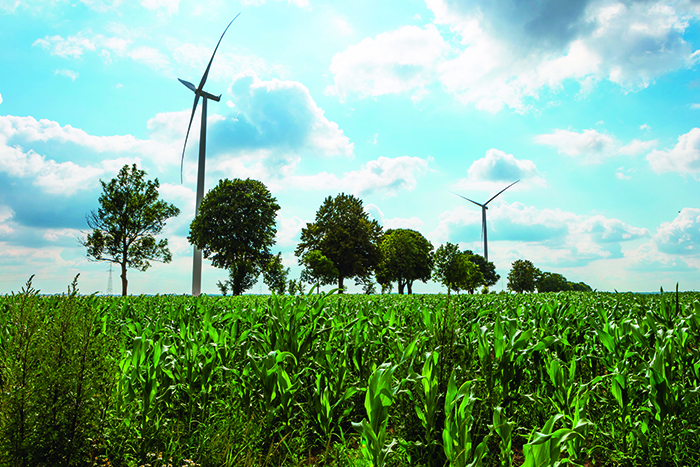
Visit ecotourism.org.au for more information and accredited operators.
COUNTRY LIFE
Love to get back to the simple things in life? Roll up your sleeves and have some fun in WA's great outdoors. You don't have to know someone who owns a farm to get amongst the action – there are many farm stays, plus horse-riding and plenty of country activities to enjoy.
Farm stays
Nothing beats the magic of waking up on a farm: rising with the dawn (thanks to the rooster); watching the resident border collies playfully leap about the grass; collecting freshly laid eggs from the chook pen; and taking a sip of milk fresh from the cows. Activities vary from property to property, but you'll usually get involved in hands-on farm duties, like feeding the animals and sheep shearing, or watching whip-cracking demonstrations and dog mustering of sheep and cattle.
For a list of WA farm stays, from camping to farm cottages, chalets and manors, visit farmstaywest.com.au or farmstaycampingaustralia.com.au. And if you want to extend your visit, go to farmsitters.com.au to find out how you could become a farm sitter. Farmers deserve a holiday too, don't they?
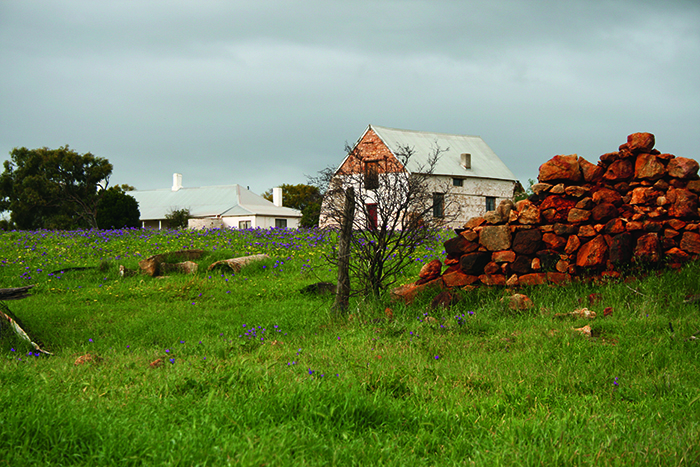
Oakabella Homestead.
Farm fun in Perth
Don't feel like a long drive deep into the country? Get a taste of farm life close to home.
-
�Landsdale Farm School is a great place for the kids to learn about farming and animals (there is even an outdoor playground and cafe on site).
-
�For wannabe farmers, Perth City Farm in East Perth is a thriving urban setup that supports sustainable food systems, with markets every Saturday offering fresh produce, and experts offering tips.
-
�If you're set on a local farm stay, there are a few in the outskirts of Swan Valley, a mere half-hour drive away. Don't miss the Swan Valley Cuddly Animal Farm while you're there.
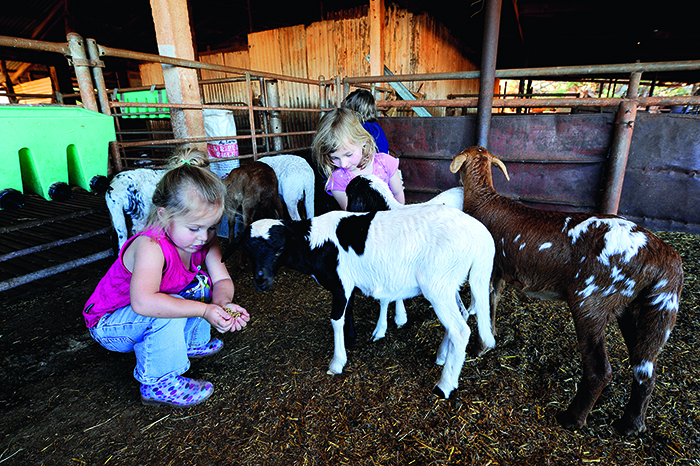
Enjoying a stay at Bullara Station.
Yallingup Shearing Shed
Admire the skills of working kelpie Bruce and border collie Lawson, as they muster the sheep for the farmers to shear. The baby lambs are always abundant, and bottle-feeding them creates smiles for the kids (and melts all the adults in the area, too). (08) 9755 2309, yallingupshearingshed.com.au.
Horse-riding
A big part of country life is the gorgeous horses, and Western Australia has plenty of opportunities to ride through nature.
NORTH WEST A horse trek through the Kimberley is a bucket-list must. A number of cattle stations offer treks, and some even allow you to experience a cattle muster. We recommend a ride along the Cockburn Range, and exploring
the trails that were part of the original stock route in the 1800s.
CORAL COAST Kalbarri has many scenic horse-riding opportunities, while Carnarvon also has a number of trail rides, incorporating sand hills and beaches. There are also horse-riding tours through the bush in Exmouth and Geraldton.
PERTH SURROUNDS Trail rides and lessons are located in hill suburbs like Darlington, Kalamunda and Mundaring. For riverside riding, head to the Swan Valley. Moore River in Gingin boasts stunning scenery.
GOLDEN OUTBACK The Golden Pipeline Heritage Trail in the Wheatbelt, and the Collie to Darkin Rail Trail are spectacular. There are many cattle stations in the Gascoyne-Murchison region that offer horse-riding. The quirky Tin Horse Highway in Kulin is also great to view the fun horse sculptures.
SOUTHWEST Margaret River is a hub for equestrian activity. There are many tours and trail rides in the region.
.jpg)
Photography Outback Advance.
MAGICAL WA
Wildflowers, waterfalls and stars… set yourself up for some natural romance.
WA's top waterfalls
While seasonal, there are incredible cascading falls throughout WA. Some plummet twenty to fifty metres off sheer granite, others follow steady inclines into the awaiting pools below. Visit during or directly after the wetter months for the best experience.
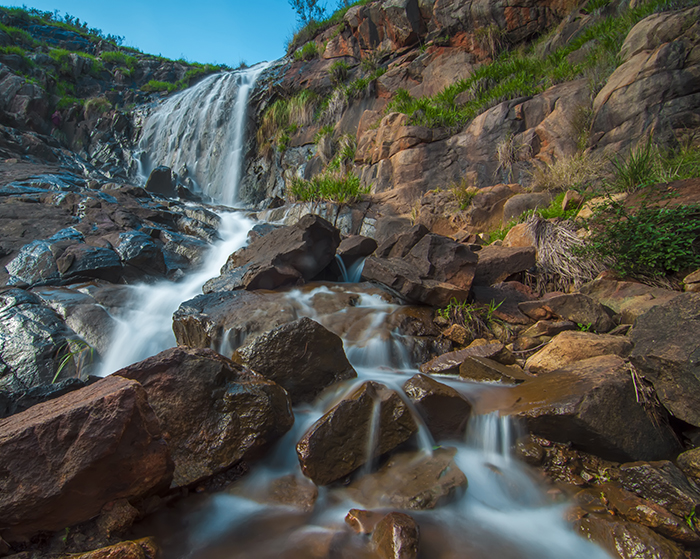
Lesmurdie Falls.
Mitchell Falls
The Kimberley does not disappoint when it comes to its waterfalls, and Mitchell Falls are nothing short of spectacular. Discover them on foot, or by scenic flight during the wet season.
King George Falls
One of WA's distinct natural wonders, no trip to the Kimberley is complete without a visit to the magnificent King George Falls. These twin waterfalls plummet 100m down red sandstone cliffs, bucketing thousands of litres of water into the pool below.
Fortescue Falls
Located in Karijini National Park, this 20m waterfall rushes down strikingly red cliff steps into the deep pool below. Surrounded by cliffs and tall trees, this is a stunningly beautiful swimming hole.
Joffre Falls
Also in Karijini, this waterfall runs down a towering, narrow gorge. Wade into the still, shallow waters, protected from the sun by looming cliff faces on either side, and enjoy the sound of the rushing falls echoing all about you.
Revolver Falls
Opinions vary about the height of Revolver Falls – some say they're as tall as 200m, but a realistic estimate is around 150m. Regardless of the exact measurement, they lay claim to be WA's highest single drop waterfall. A six-hour walk from Lake Argyle.
Lesmurdie Falls
A mere 22km east of Perth, this waterfall is one of the largest and most amazing to be found in the Darling Ranges, tumbling 50m down a steep cliff etched with green, before splashing onto smooth rocks below.
Serpentine Falls
In the Serpentine National Park, 55km southeast of Perth, these falls flow down from the Darling Scarp into a clear, natural pool. Take the 400m Falls Walk Trail to the popular swimming and picnicking spot. Depending on the rainfall, you may find not just one, but two waterfalls.
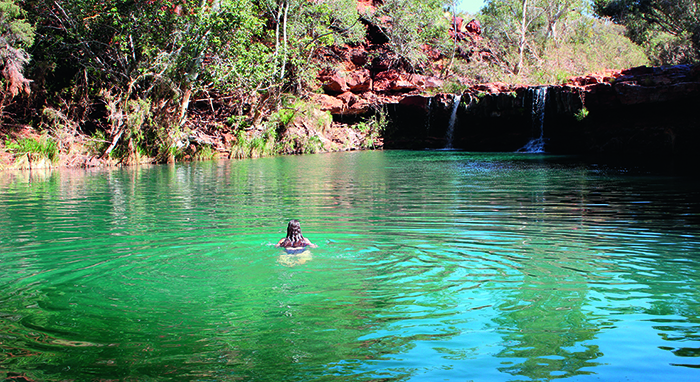
Fern Pool at Dales Gorge, Karijini National Park.
Hovea Falls
Surrounded by fields of wildflowers in the springtime, the lovely Hovea Falls in Perth's John Forrest National Park flow over a gradually declining cliff into ankle-deep pools.
Lane Poole Reserve
This modest 10m waterfall can be found near Dwellingup. It runs over smooth rock into a natural pool surrounded by rich karri forests.
Fernhook Falls
In Mount Frankland National Park, the Fernhook Falls rush over granite boulders and into the gushing rapids when water levels are high, while remaining tranquil and calm in the summer. The boardwalk over the river and falls allows for a scenic stroll.
Beedalup Falls
Bound by lush green bush and the forests of Beedelup National Park, these cascades are beautiful and serene. The suspension bridge and nearby walk-through tree are popular with visitors.
WILDFLOWERS
Western Australia is home to more than 12,000 species of wildflowers, with more than 60 per cent found nowhere else in the world. Every year, these unique blooms bring a spectacle of colour and scent to 2.5 million sqkm, attracting thousands of tourists and scientists.
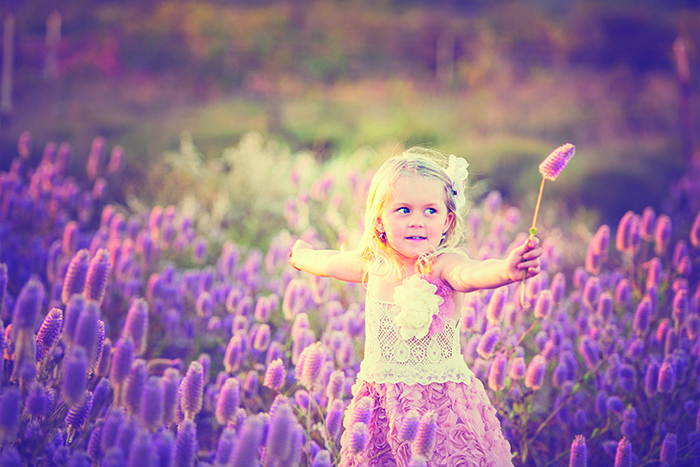
Generally, wildflowers begin to appear in June in the north of the state, extending through to the south in November, but peak period is usually August, September and October. All kinds of spring events are held to celebrate and showcase theflowers, including the Great Southern Bloom festival and Kings Park Festival. See our events guide (p23) for more.
Top wildflower destinations
CORAL COAST Exmouth, Coral Bay and the Cape Range National Park, the Shark Bay World Heritage Site, Kalbarri National Park, Coalseam Conservation Park, Lesueur National Park, Port Denison, and Badgingarra National Park
GOLDEN OUTBACK Murchison, Gascoyne (heading east from Carnarvon), Dalwallinu and Wongan Hills in the Wheatbelt, Goldfields and Fitzgerald National Park.
PERTH Kings Park.
THE SOUTHWEST Leeuwin-Naturaliste National Park, Stirling Range National Park, D'Entrecasteaux National Park.
STARGAZING
Perth is still the most isolated capital city in the world, which means you don't need to travel far from the bright lights to gaze up at a dark night sky. The Stargazers Club WA shares its top five stargazing destinations.
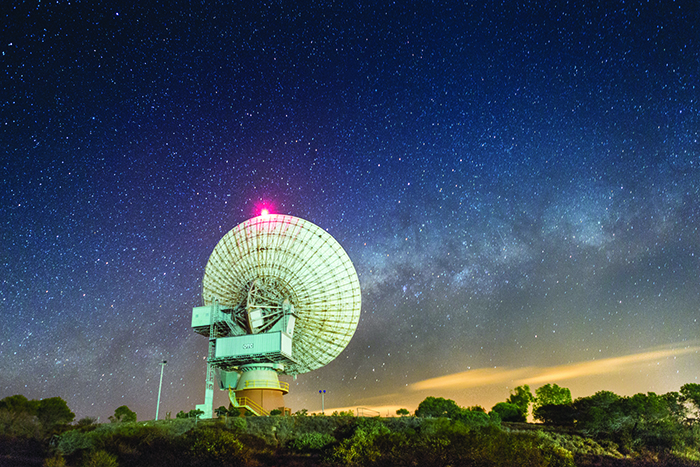
The OTC Dish, Carnarvon.
THE WHEATBELT Drive just one to two hours out of Perth on a moonless night, and you can see the Milky Way galaxy stretch across the night sky. The Geminid meteor shower in mid-December each year is a must-see, while the telescopes at Gingin Observatory provide opportunities for a closer look.
LAKE BALLARD IN THE GOLDEN OUTBACK The stars over the Gormley sculptures on the lake bed at Lake Ballard will take your breath away. Stargazers need to be self-sufficient to camp at Lake Ballard, with all their own food, water and supplies. If you're there on a moonless night, the Milky Way will look like a band of cloud across the night sky.
ROEBUCK BAY NEAR BROOME The Staircase to the Moon appears three times each month from March to October. As the moon rises, the reflection of its light on the tidal flats is a real treat. Take a comfy chair and picnic to enjoy. The Staircase can also be seen from many locations along the Pilbara coast, including Onslow, Dampier, Point Samson, Hearson's Cove, Cossack and Port Hedland.
ALBANY AND ESPERANCE along the southern coast If you're lucky, you may witness the Aurora Australis. It's very rare in WA, and usually only ever seen from the very south when it occurs. Auroras are caused when a burst of energy from the sun hits Earth's magnetic field. The collision results in spectacular hues of green and red colour across the night sky.
PERTH HILLS Perth Observatory runs stargazing nights where you can learn more about astronomy. Keep an eye out for the most famous of Australian constellations, the Southern Cross.
.jpg)
Lake Ballard's sculptures by night (photography Colin Legg Photography).
Astrofest 2016
Want to learn from the experts? Join in on the fun at the annual Astrofest, held at Curtin Stadium. The 2016 event will be held on March 12, with dozens of telescopes to look through, local astronomers, guest presenters and plenty of activities for the kids. Visit astronomywa.net.au.
Heavenly features
Download these stargazing apps to your phone
-
�SkySafari helps you identify stars and constellations.
-
�Aurora Forecast will let you know if there's any chance of seeing the majestic aurora.
-
�Fireballs in the Sky provides updates on when to expect the next meteor shower.
(1).jpg)
Stars over the Pinnacles (photography Grahame Kelaher).
WA'S MOST BIZARRE LANDSCAPE
Drive two-and-a-half hours north of Perth to see the eerie, alien-like formations of The Pinnacles. Over 30,000 years ago, the receding ocean left deposits of seashells on shore, and yellow sand dunes were created. The Pinnacles are scattered across the desert by the thousands. Some are as high as 3.5m, some have jagged edges, and others have rounded-off domes. They are located in the Nambung National Park, home to grey kangaroos, emus and reptiles.
CAMPING
What better way to enjoy the outdoors than camping with the clan? The popular pastime has come a long way over the years, but the primal urge to get back to basics will always remain.
.jpg)
Warroora Station Lagoon Camp (photography angewallphoto.com.au).
Camping styles
From five-star glamping, catered camping, eco stays and outback station experiences, to simply pitching a tent yourself, there's something for everyone – and WA's great climate means you can do it all year round.
NATIONAL PARKS If you're aiming to spot some wildlife, head to one of the picturesque camping-friendly national parks across the state. For more information, visit parkstay.dpaw.wa.gov.au.
CARAVAN PARKS Great for the first-timer, with all the comforts of home (bathrooms, power outlets and barbecue facilities) in one location. You can even rent a caravan or cabin on site. Book ahead – regulars have their favourite seaside spots, and some stay all summer (or year) long!
GLAMPING Airy safari tents, with comfy beds and linen, can be enjoyed in the Kimberley and Pilbara regions.
CATERED CAMPING Experience authentic camping without the dreaded set up and clean up. WA Wilderness will prepare everything in advance – all you have to do is show up. wawilderness.com.au. STATION STAYS Experience the real characters of the outback on a rural station stay. Working stations are scattered around WA and within easy reach of the state's three World Heritage areas. You will also find them along the Gibb River Road 4WD track between Derby and Kununurra. Camping and caravan facilities are often available. See the Adventurer section (p106) for more.
CARAVAN OR MOTORHOME ROAD TRIPS If you're in a position to purchasea caravan or motorhome, go for it – they're a great way to explore WA for extended periods. These days, you can roam the Kimberley for months in a mobile home, complete with fridge, washing machine and all mod cons. Caravans are also available for hire if you're not ready to commit.
.jpg)
Cape Range National Park (photography Jed Newman, Exmouth Visitor Centre).
Top 10 WA camping spots
1 Leeuwin-Naturaliste National Park
On the coastal Cape to Cape Track, south of Yallingup, you can camp beside a beach and enjoy world-class surf breaks and stunning bush walks, excellent fishing and birdwatching.
2 D'Entrecasteaux National Park
Renowned for its unique botanical and geological features, this wild and rugged park near Pemberton boasts karri forests fringed by beaches.
3 Cape Le Grand National Park
Home to Lucky Bay – Australia's whitest beach – Cape Le Grand National Park is often rated among the country's top getaways for fishing, whale-watching, hiking and more.
4 Cape Range National Park
Beside the UNESCO World Heritage-listed Ningaloo Reef, this park offers amazing outback adventures, from 4WDing to gorge hiking.
5 Francois Peron National Park
Take a 4WD camping trip and discover some of the reasons why Shark Bay earned World Heritage status. From the clifftops of Cape Peron, you can see dugong, manta rays, turtles and sharks swimming in the water below. Visit Monkey Mia to meet dolphins.
6 Fitzgerald River National Park
Set up camp in the heart of one of the largest and most botanically significant national parks in Australia, with around 1800 species of flowering plants alone, including banksias, hakeas, bottlebrush, feather flowers, quaalup bell and many others. Here you can go bush walking, camping, canoeing, fishing and whale-watching.
7 Purnululu National Park, Kimberley
Earning a place on the National and World Heritage lists, Purnululu National Park is home to the Bungle Bungle Range. 350 million years in the making, it's the most unique and captivating range on Earth. Take in the full spectacle on a scenic flight from Kununurra, Broome or Halls Head, or on an open-door helicopter ride from within Purnululu itself.
8 Karijini National Park, Kimberley
This is one of Australia's largest and most spectacular national parks. Climb, swim, or gaze into the depths of Karijini's 100m chasms, revealing four billion years of the Earth's history. Follow the trails, descend into cavernous gorges, cool off in inviting pools beneath plunging waterfalls, or scale Western Australia's second-highest peak, Mt Bruce.
9 Lane Poole Reserve
Near Dwellingup, in the wooded valleys of the Darling Scarp and Murray River, Lane Poole Reserve is a 50,000ha nature-lover's paradise. There are numerous opportunities for swimming, fishing, canoeing and rafting.
10 Beelu National Park, Perth Hills
One of the first stops along the epic 1000km Bibbulmun Track, from Kalamunda to Albany, the camping here is at 'luxury' level, complete with hot showers and kitchen facilities.
Top 10 family camping spots
-
Jurien Tourist Park, Jurien Bay
-
�Congelin campground, Dryandra Woodland, Peel
-
�Beelu campground, Perth Hills Discovery Centre, Mundaring
-
�Bottle Bay campground, Francois Peron National Park, Shark Bay
-
�Lake Leschenaultia, Perth Hills
-
�Honeymoon Pool, Wellington National Park, Collie
-
�Dampier Peninsula, West Kimberley
-
�Bayview Coral Bay or People's Park Caravan Village, Coral Bay
-
�Allison Camping Ground, Rottnest Island
-
�Guilderton Caravan Park, Moore River